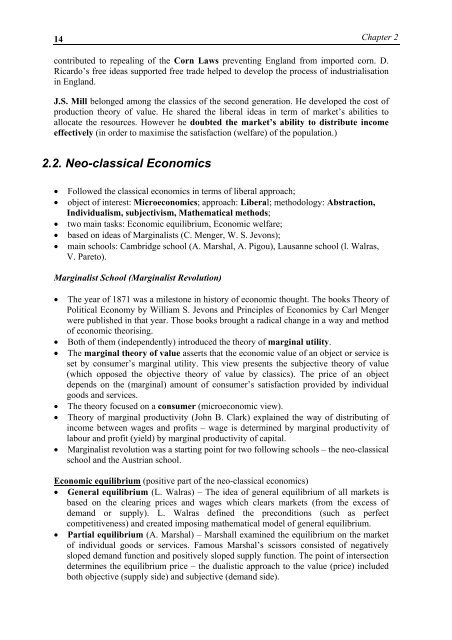MacroeconomicsI_working_version (1)
Create successful ePaper yourself
Turn your PDF publications into a flip-book with our unique Google optimized e-Paper software.
14<br />
Chapter 2<br />
contributed to repealing of the Corn Laws preventing England from imported corn. D.<br />
Ricardo’s free ideas supported free trade helped to develop the process of industrialisation<br />
in England.<br />
J.S. Mill belonged among the classics of the second generation. He developed the cost of<br />
production theory of value. He shared the liberal ideas in term of market’s abilities to<br />
allocate the resources. However he doubted the market’s ability to distribute income<br />
effectively (in order to maximise the satisfaction (welfare) of the population.)<br />
2.2. Neo-classical Economics<br />
• Followed the classical economics in terms of liberal approach;<br />
• object of interest: Microeconomics; approach: Liberal; methodology: Abstraction,<br />
Individualism, subjectivism, Mathematical methods;<br />
• two main tasks: Economic equilibrium, Economic welfare;<br />
• based on ideas of Marginalists (C. Menger, W. S. Jevons);<br />
• main schools: Cambridge school (A. Marshal, A. Pigou), Lausanne school (l. Walras,<br />
V. Pareto).<br />
Marginalist School (Marginalist Revolution)<br />
• The year of 1871 was a milestone in history of economic thought. The books Theory of<br />
Political Economy by William S. Jevons and Principles of Economics by Carl Menger<br />
were published in that year. Those books brought a radical change in a way and method<br />
of economic theorising.<br />
• Both of them (independently) introduced the theory of marginal utility.<br />
• The marginal theory of value asserts that the economic value of an object or service is<br />
set by consumer’s marginal utility. This view presents the subjective theory of value<br />
(which opposed the objective theory of value by classics). The price of an object<br />
depends on the (marginal) amount of consumer’s satisfaction provided by individual<br />
goods and services.<br />
• The theory focused on a consumer (microeconomic view).<br />
• Theory of marginal productivity (John B. Clark) explained the way of distributing of<br />
income between wages and profits – wage is determined by marginal productivity of<br />
labour and profit (yield) by marginal productivity of capital.<br />
• Marginalist revolution was a starting point for two following schools – the neo-classical<br />
school and the Austrian school.<br />
Economic equilibrium (positive part of the neo-classical economics)<br />
• General equilibrium (L. Walras) – The idea of general equilibrium of all markets is<br />
based on the clearing prices and wages which clears markets (from the excess of<br />
demand or supply). L. Walras defined the preconditions (such as perfect<br />
competitiveness) and created imposing mathematical model of general equilibrium.<br />
• Partial equilibrium (A. Marshal) – Marshall examined the equilibrium on the market<br />
of individual goods or services. Famous Marshal’s scissors consisted of negatively<br />
sloped demand function and positively sloped supply function. The point of intersection<br />
determines the equilibrium price – the dualistic approach to the value (price) included<br />
both objective (supply side) and subjective (demand side).




